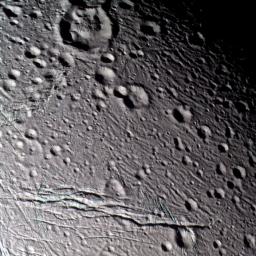More on Enceladean Atmosphere discovery
When I first saw the subject of this release, I thought it refered to another instrument, which I will not name here but I can tell you it wasn't us (ISS). Let's just say that it can't be sputtering or some other process that would dislodge water ice from the surface.
I think we also need to think in terms of sources. Personally, I see nothing on the surface that screams volcano or caldera (maybe...). I see nothing but craters in terms of point sources. However, both VIMS and ISS saw differences in grain size at the fracture zones, both in the bedice and in flat deposits at the base of scarps (not the same as the talis). In the details I am of course using the ISS images released yesterday. There is one fracture which appears fairly young since it seems to not have been smoothed yet by the effects of micrometeorites. In global images there appears to be a dark "deposit" surrounding that fracture. So, I'm thinking, what if the fractures are the source of the volcanism. They open up, expell gases (or water/ammonia mist) from the interior, close back up. The gases freeze quickly, and either escape Enceladus to become the E-ring, become part of Enceladus' atmosphere (then later the E-ring), or fall back on Enceladus whiter than freshly fallen snow.
I like to think of Enceladus as the world of contradictions. It's got both very young (< 10-100 Ma) surfaces, and comparatively very old surfaces (500-1000 Ma). It seem that ammonia would be needed to depress the melting point enough to cause this level of activity, but no ammonia has been seen on the surface (though this can be explained away easily due to the UV effects on exposed ammonia). Some other inconsistencies maybe released in the coming days.
Well, I better start gearing to get a nice seat for the second Cassini Session. I will try to post a message regarding info from these sessions later today here.


